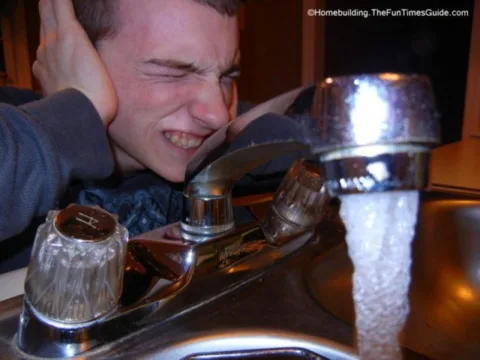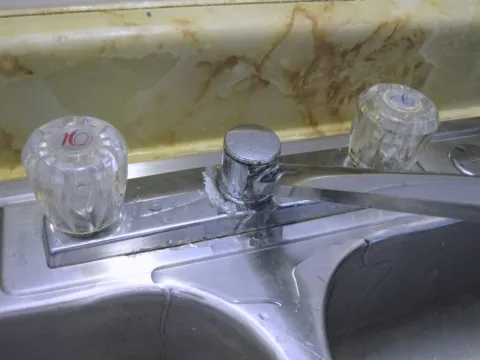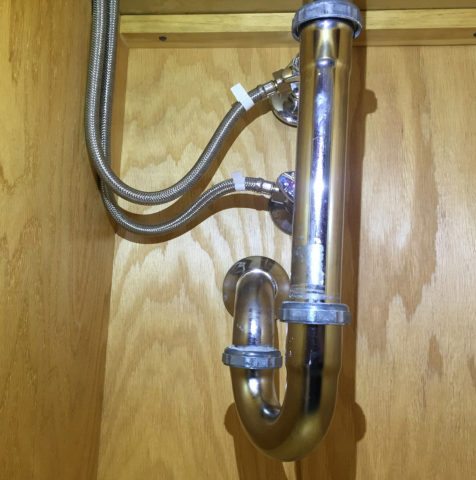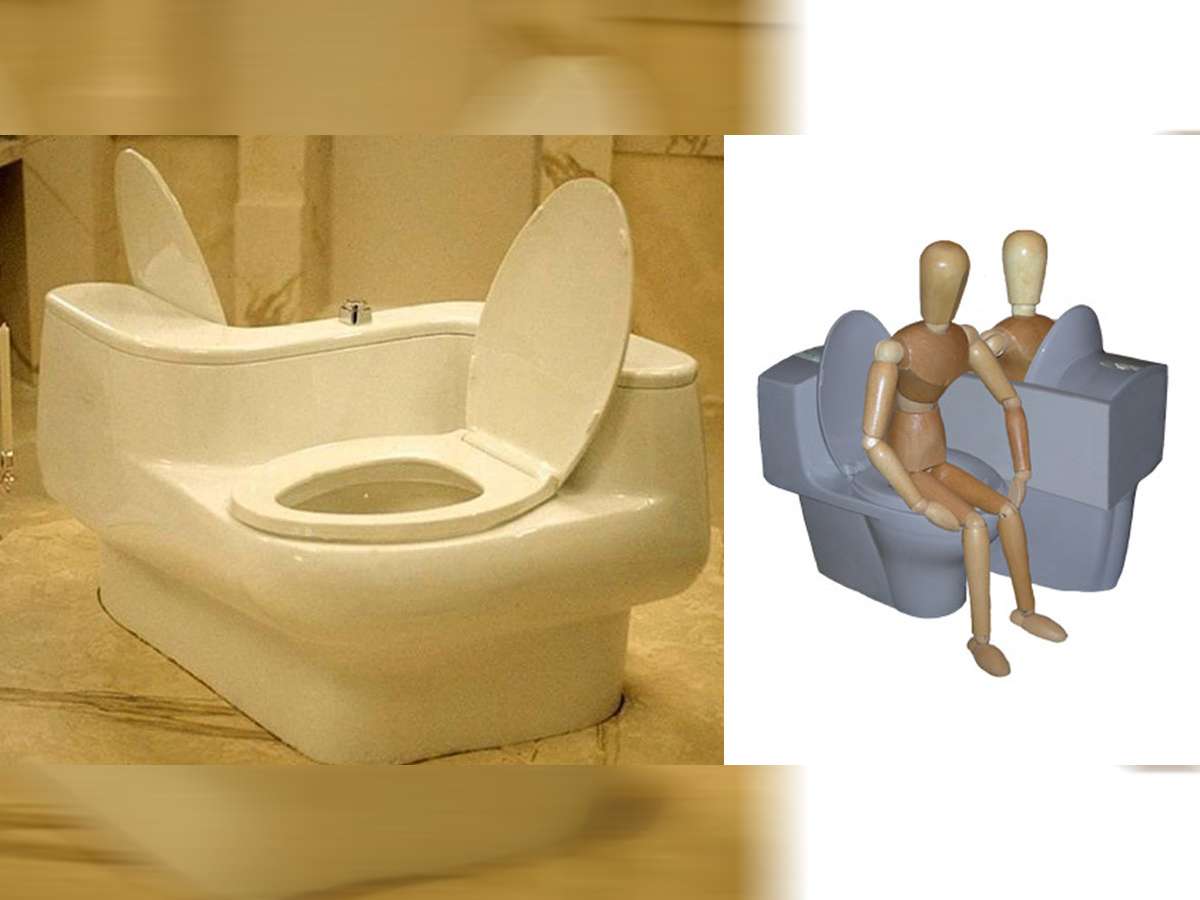Do you have a water faucet that whines, screeches, or squeals when you turn it on?
There are a few reasons why this annoying little problem occurs.
By the way, I love that my son is such a willing participant in front of and behind the camera. The photo you see is him, and the angle and expression were all his idea. Gotta love him!
Is this a DIY faucet repair project for able-bodied homeowners?
It most certainly is, so pay attention, y’all.
#1 – Assess The Problem
There are several possible reasons why your plumbing is talking to you when it should be a silent servant.
First and foremost, I’m talking about pipes that whine, screech, or squeal. I’m not talking about banging pipes — that’s a different set of problems altogether.
Why am I talking about screeching pipes?
Because my hot water faucet (and sometimes the cold faucet) in the kitchen has been begging for attention lately — and I find myself faced with yet another DIY faucet repair project.
I think my problem will be fairly easy to fix compared to most though, because the noise being made is localized to my kitchen faucet.
Here’s an overview of my kitchen faucet problems:
- I have separate faucet knobs for the hot and cold water.
- The faucet only squeals when the hot or cold water is turned on at very low pressure.
- To silence the screeching, I turn up the water pressure via the knob.
My problem will likely be solved by replacing the cartridge or stem that’s located inside of the faucet handle itself.
I have an older Price Pfister faucet that is original to my 23-year-old house. I guess you could say I’ve gotten my money’s worth out of it, eh?
TIP: I typically visit a few sites like The Family Handyman and This Old House to diagnose the problem before I dive into doing a repair project.
#2 – Fix The Problem
After conducting some research, here are the top 2 things that I think might resolve the screeching faucet issue:
- Replace washers and/or a valve stem.
- Check the water pressure.
Here’s how I did each of those things to solve my kitchen faucet problems.
First, I checked the washers and valve stem…
I’ve never replaced or repaired anything on my kitchen faucet — so the washers/valve stem would seem to be a likely starting point.
Washers become more flimsy over time and, therefore, do not have the same control over the water flowing by them. The water tends to control them, rather than the other way around.
Before you get started with your faucet repair, you must figure our where the sound is coming from:
- If the sound is occurring at the faucet — shut off the water just below the sink, and let the remaining water run out by turning on the water.
- If the screeching is coming from inside of your wall — turn off the water that comes into the house. There should be a valve where the pipe enters the house in your basement or crawl space.
After you’ve turned off the water, here are the steps to fix the faucet:
- Remove the decorative “H” or “C” covers — if you have them.
- Use a Phillips screwdriver
or allen wrench to unscrew the set screw.
- Pop off the handle.
- Grab your bath socket wrench
to remove the stem by unscrewing it.
- Remove the remaining nuts with a regular wrench.
- Replace all old parts with new ones.
Then, I checked the water pressure…
It’s been a few years since I’ve had a new water pressure regulating valve installed (where the water enters the house — located right after the whole house on/off valve).
You’ll need to go to your local hardware store and pick up a pressure gauge. It should be somewhere 50 to 90 lbs. (Mine should be less than that — since the valve has a tag on it that states 25 lbs. to 75 lbs.)
In order to change the pressure you’ll need to:
- Grab an adjustable wrench
.
- Loosen the nut on the regulating valve.
- Tighten the bolt.
- Tighten the nut down and make slight adjustments — as necessary.
#3 – Check To See If It’s Fixed
Uh oh, are your pipes still screeching?
That means your kitchen faucet repair isn’t done yet!
Here are 3 other things that can cause screeching pipes:
- Air in the pipes – If you suspect this is the problem, turn your faucet ON and turn OFF the shut-off valve in your house — until it runs dry. Turn your faucet OFF and turn the main valve back ON. Did it work? If not, try one of the other remedies.
- Sediment in the water line – This is not likely your problem. But it wouldn’t hurt to remove the aerator
and let the water run for a couple of minutes. Clean the screen on the aerator while you’re at it.
- Kinks in the water line – You won’t likely hear a whining noise at your spigot if this is the problem. It will be located somewhere near the kink. Inspect the entire length of your water line and correct any problems that you may come across.
It’s usually fairly obvious to me what the problem is — you may find yourself in a similar situation. If not, try some of the other fixes that I’ve described.
If you still have screeching pipes, take a deeper dive into some of the sources that I’ve noted below for DIY faucet repair.
You can probably save yourself some major bucks by trying these fairly simple solutions before you call a plumber — because we all know the type of rates that they typically charge!
More Kitchen Faucet Repair Tips
In addition to the links I’ve included above, here are some other resources to help with your faucet repair project:
- 10 Quick Fixes For Problem Faucets
- What Causes The Whine When Faucets Are Turned Off & On
- How To Fix Whining Water Pipes (video)
- Noisy Pipes – What Causes Them?
- What You Should Look For When Hiring A Plumber
I started as a home-stalker… visiting brand new homes under construction in the neighborhoods near my house. That inspired me to write about home building and home renovation projects — chronicling homes during different phases of construction from a consumer's point-of-view. Basically, the tips you'll find in my articles are a collection of checklists for what I think should (and should not) go into building or remodeling a quality home.








